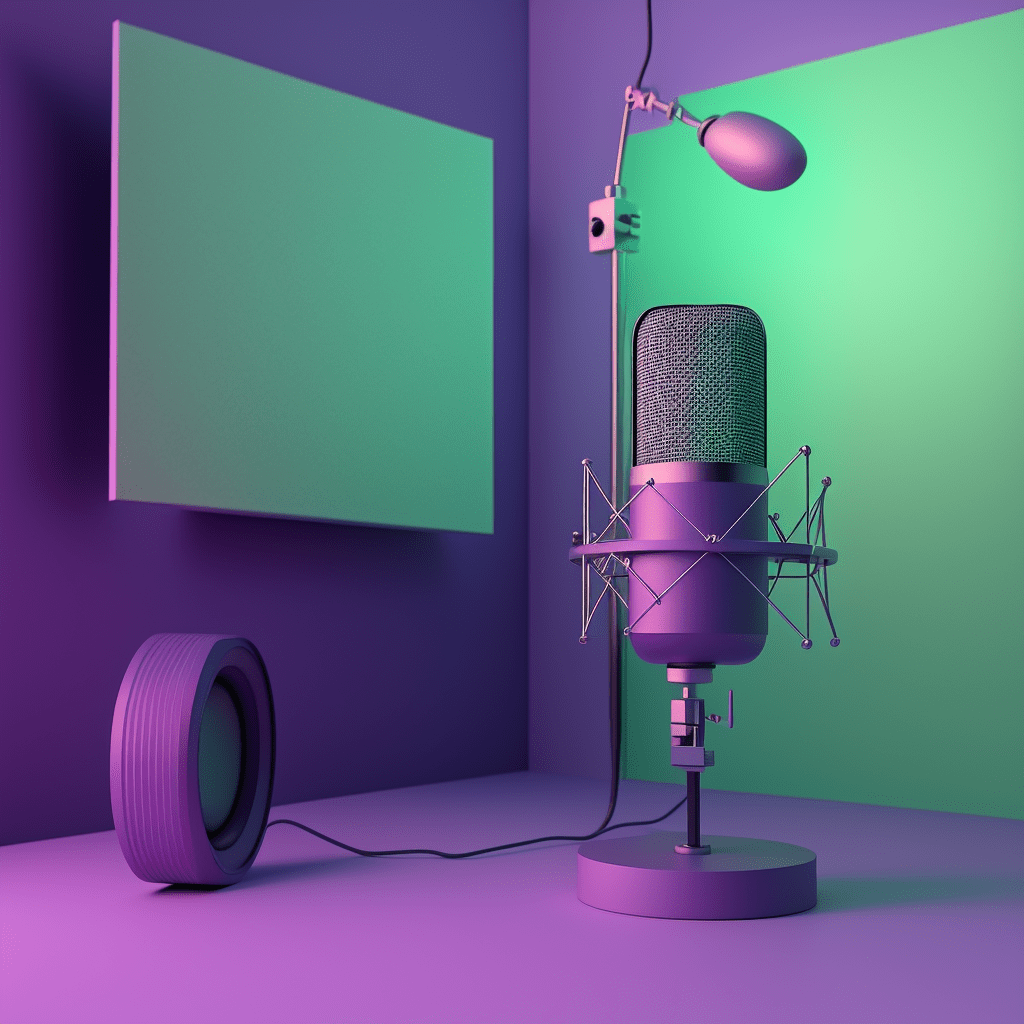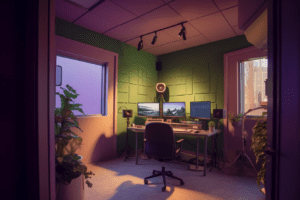Ready to start your podcast? Follow our full step-by-step guide on how to produce a podcast, from planning to distribution.

Starting a podcast might feel like a big task, but we’re here to help you make it a breeze. At Earworm, our team has been in the podcast production game for years, helping creators just like you bring their ideas to life. We’ve tackled every challenge and celebrated every win, and now we’re excited to share our tips with you.
We’ve packed this guide with all the practical advice and insights we’ve learned from working on hundreds of podcasts. Whether you’re just getting started or looking to level up, we’ve got you covered. We’re super passionate about podcasting and can’t wait to see you succeed.
With our help, you’ll be producing your podcast in no time. Here’s your step-by-step guide on how to start a podcast in 2024!
What are the benefits of podcast production?
Podcast production is where your ideas turn into an engaging show. It’s all about creating a high-quality, professional experience for your listeners. But why bother with podcast production?
First, podcasts help you connect with your audience in a personal way. When you share your passion and knowledge through your voice, it creates a deep connection. Your listeners can feel the emotions and nuances that make your content special.
Podcasts are also super convenient. People can listen while driving, exercising, or doing chores. Your content becomes a part of their daily routine, reaching folks who might not have time to read a blog or watch a video.
Plus, podcasting can boost your credibility. By sharing valuable insights and interviews, you build trust and establish yourself as an expert. This can lead to exciting opportunities like speaking engagements and sponsorships.
Let’s not forget the creative freedom! You get to shape your show’s format, style, and content, letting your unique personality and brand shine.
At Earworm, we know podcast production inside out. Our team blends technical know-how with creative flair to make your podcast stand out. Need help with scripting, recording, or editing? We’ve got you covered.
Get in touch today for a free strategy call and let’s create something amazing together!
Planning your podcast
Ready to jump into the world of podcasting? First things first, you need a solid plan. Don’t worry, we’ve got your back!
Start with your podcast’s theme. What are you passionate about? What do you want to share with the world? Pick something you love because you’ll be talking about it a lot. Trust us, enthusiasm is contagious.
Next, think about your audience. Who are they? What do they like? Knowing your audience helps you create content they’ll love. Picture your ideal listener. Are they into tech, health, comedy, or maybe true crime? Tailor your content to them.
Now, let’s talk format. Do you want a solo show, interviews, or a co-hosted podcast? Each format has its perks. Solo shows give you complete control, interviews bring in new perspectives, and co-hosts can make for lively banter.
Episode length is another thing to consider. Keep it manageable – anywhere from 20 to 60 minutes is great. Consistency is key. Whether you’re releasing episodes weekly or bi-weekly, stick to your schedule to keep your audience coming back for more.
Lastly, brainstorm a catchy name and create an outline for your first few episodes. A good name is memorable and hints at your content. Your outline keeps you focused and ensures you’re covering all the juicy details.
At Earworm, we love helping new podcasters get started. Need more tips or a brainstorming session? We’re just a call away!
Choosing the right equipment
You don’t need a fancy studio to start a killer podcast, but some basics will make a world of difference.
First up, the microphone. Ditch the built-in laptop mic – trust us on this. We recommend the Audio-Technica ATR2100x-USB or the Blue Yeti. Both are affordable and sound fantastic. They’re USB mics, which means you plug them right into your computer and you’re good to go.
Headphones are a must. You’ll want something comfy for those long recording sessions. Try the Sony MDR7506. They’re durable, great for monitoring your sound, and won’t break the bank.
Ever heard of a pop filter? It’s a little screen that sits between you and the mic, reducing those pesky popping sounds from plosive consonants (like P’s and B’s). Cheap and effective, it’s a great addition to your setup.
If you’re planning to record on the go, the Zoom H5 portable recorder is a gem. Perfect for interviews or capturing sound outside your usual spot, it’s versatile and reliable.
And don’t forget a mic stand or boom arm. Keeping your mic steady and at the right height makes a big difference in sound quality. Plus, it frees up your hands to gesticulate wildly as you podcast.
Starting simple is totally fine. You can always upgrade later. If you’ve got questions about equipment, hit us up. We’re here to help you sound your best from day one.
Setting up your recording space
Alright, you’ve got your gear – now let’s talk about where to record. A little effort can make your recordings sound pro!
Find a quiet spot. Background noise is your enemy. We’re talking barking dogs, traffic, and that noisy fridge. Choose a room with minimal outside noise and let everyone know you’re recording to avoid interruptions.
Soft furnishings are your friends. They help absorb sound and reduce echoes. Think rugs, curtains, and cushions. Recording in a room full of hard surfaces? Try throwing a blanket over some of them. It’s not glamorous, but it works.
Consider your mic placement. Set it up at a comfortable height, about six inches from your mouth. Angle it slightly to the side to avoid those harsh “P” and “T” sounds.
Using a desk? A boom arm or mic stand keeps things stable and reduces noise from any accidental bumps. Plus, it frees up space for your notes, coffee, or wild hand gestures.
Lighting matters if you’re doing video podcasts. Natural light is great, but if that’s not an option, a couple of softbox lights can do wonders.
Don’t forget to make it comfy. You’ll be spending time here, so a good chair and a tidy space can make a big difference.
Scripting your episodes
Ready to bring your podcast to life? It’s time to script your episodes. It might sound daunting, but trust us – a good script is your best friend.
We recommend starting off with an outline. Jot down the main points you want to cover. Think of it as your roadmap. This keeps you on track and ensures you hit all the important topics without wandering off into the weeds.
Next, write your introduction. Grab your listeners’ attention right away. Introduce yourself, your podcast, and what this episode is about. Keep it snappy and engaging.
Then, dive into the meat of your episode. Write down key points, questions, or topics you want to discuss. If you have guests, prepare some questions in advance. But don’t script every single word – leave room for spontaneity and natural conversation. Your listeners will appreciate the genuine feel.
Add transitions to help your episode flow smoothly from one topic to the next. These can be as simple as, “Next up,” or, “Let’s move on to.” They keep your audience engaged and make your podcast easier to follow.
Don’t forget the outro. Summarise the episode, thank your listeners, and let them know what’s coming next. Encourage them to subscribe, leave a review, or follow you on social media.
Practice makes perfect. Read your script out loud a few times. It’ll help you catch any awkward phrases and get comfortable with your material.
Here at Earworm, we’ve helped many podcasters nail their scripts. If you need a hand with yours, reach out. We’re here to help you with podcast script writing.
Recording your podcast
It’s showtime! Recording your podcast can be a blast if you’ve got the right setup and mindset.
Make sure your recording space is all set – quiet, cozy, and free from distractions. Your mic should be at a good height, about six inches from your mouth. Pop on those headphones and do a quick sound check. You want clear, crisp audio without any background noise.
Hit record and start with a warm-up. Chat a bit to get into the groove and relax. Remember, this should be fun! When you’re ready, dive into your intro. Speak clearly and at a natural pace. Imagine you’re talking to a friend – it helps keep your tone conversational and engaging.
If you stumble or make a mistake, no worries. Just pause, take a breath, and continue. You can edit out any flubs later. Keep an eye on your energy levels. Smiling while you talk can actually make you sound more enthusiastic and approachable.
For interviews, keep things flowing naturally. Let your guests shine, but don’t be afraid to jump in with follow-up questions or comments. The best conversations often come from unscripted moments.
Take breaks if needed. It’s better to stay fresh and focused than to push through when you’re tired. When you’re done, save your file immediately. Trust us, nothing’s worse than losing a great recording!
Editing and post-production
You’ve recorded your podcast – awesome! Now comes the magic of editing and post-production. This is where you polish your raw audio into a smooth, professional episode.
First off, choose the right software. Audacity and GarageBand are great free options, while Adobe Audition offers more advanced features. We use these tools to trim out mistakes, awkward pauses, and any unwanted noise. It’s like giving your podcast a good haircut – you want it to look (or in this case, sound) its best.
Listen through your recording and make notes on any parts that need fixing. Cut out ums, ahs, and stumbles to keep the flow natural and engaging. Balance the audio levels to make sure your voice and any guests’ voices are clear and at the same volume.
Don’t forget to add intros, outros, and any transitions. This adds structure and keeps your listeners hooked from start to finish. Throw in some background music or sound effects to enhance the listening experience, but keep it subtle. You don’t want it to overpower your voice.
Once you’re happy with the edits, export your file in a high-quality format, like MP3 or WAV. Listen to the final version with fresh ears or have a friend give it a listen to catch anything you might’ve missed.
We know that editing can feel daunting at first. Take it from us, it gets easier with practice. Need a hand with editing or want to outsource it entirely? We’re here to help turn your raw recordings into podcast gold.
Adding music and sound effects
Let’s jazz up your podcast with some music and sound effects! This is where you can really set the mood and make your episodes pop.
Music can add a lot to your podcast. Think about using a catchy intro and outro tune. It helps to establish your brand and signals the start and end of your show. We recommend finding royalty-free music on sites like Epidemic Sound or AudioJungle. You’ll find a wide variety of tracks that can fit your podcast’s vibe perfectly.
Sound effects are like the seasoning to your podcast soup. They can emphasise points, transition between segments, or add a bit of fun. Maybe you want a “ding” sound when a new guest joins, or some ambient noise to set a scene. Just remember, less is more. You want to enhance your podcast, not overwhelm it.
Timing is everything. Place your music and sound effects strategically. An upbeat track can energize the beginning of your podcast, while softer background music can underscore a reflective moment. Make sure the volume of your music doesn’t drown out your voice – your listeners should always hear you clearly.
Experiment and have fun with it. This is your chance to get creative!
Creating eye-catching cover art
Cover art is the first thing people see when they find your podcast, so you want it to stand out.
Start by brainstorming ideas that reflect your podcast’s theme and vibe. What’s the overall feel of your show? Fun and quirky? Serious and informative? Your cover art should give potential listeners a hint of what to expect. Keep it simple but striking. Too many details can be overwhelming in a tiny thumbnail.
Colors play a big role. Bright, contrasting colors catch the eye and make your artwork pop. If you have a brand color scheme, stick with that to keep things consistent.
Don’t forget about typography, either, Your podcast name should be easy to read even at a small size. Choose a clean, bold font that matches your podcast’s tone.
Got an idea? Great! Now, it’s time to bring it to life. Tools like Canva or Adobe Spark are user-friendly and perfect for creating stunning cover art, even if you’re not a design pro. Upload your images, play around with fonts and colors, and see what works best.
Don’t hesitate to get feedback. Show your design to friends or family and see what catches their eye. Sometimes a fresh perspective can highlight something you’ve missed.
Writing episode descriptions
In our opinion, writing descriptions is one of the most important stages of podcast production. It might seem like a small detail, but it’s actually super important. A good description can hook potential listeners and give them a reason to hit play.
Think of your episode description as a mini-ad for your content. Start with a catchy first sentence that grabs attention. You want to pique curiosity right away. Maybe drop an intriguing question or a surprising fact related to your episode. Something like, “Ever wondered how your favorite tech gadgets are made?” can do the trick.
Next, give a brief overview of the episode. Highlight the main points or topics you cover, but keep it concise. You’re aiming to give listeners a taste without spilling all the beans. Mention any special guests and why they’re awesome. People love knowing they’re about to hear from experts or interesting personalities.
Use keywords naturally in your description. This helps with searchability and makes your podcast easier to find. Think about what terms people might use to find content like yours and weave them into your text seamlessly.
Don’t forget a call to action. Encourage listeners to subscribe, leave a review, or visit your website for more info. Make it easy for them to engage with your podcast beyond just listening.
At Earworm, we’ve written countless episode descriptions that catch eyes and ears. If you’re feeling stuck, we’re here to help craft descriptions that draw in listeners and keep them coming back for more.
Hosting and distributing your podcast
At this stage of podcast production, you should have your episodes ready to go. It’s time to get them out into the world! Hosting and distributing your podcast might sound technical, but it’s really straightforward once you get the hang of it.
Above all else, you need a podcast hosting service. We recommend platforms like Libsyn, Podbean, or Anchor. These services store your audio files and generate an RSS feed – a fancy term for the link that directories like Apple Podcasts and Spotify use to fetch and display your episodes.
Once you’ve picked a host, upload your episodes along with their descriptions and cover art. The hosting service will guide you through this process. It’s usually as simple as dragging and dropping your files and filling out a few fields.
Now, let’s get your podcast listed on major directories. Your hosting service often helps with this, but you’ll need to submit your RSS feed to platforms like Apple Podcasts, Spotify, Google Podcasts, and Stitcher. Each platform has its own submission process, but don’t worry – it’s usually a one-time thing. Once you’re set up, new episodes will automatically appear on all your chosen platforms.
Engage with your audience by sharing your episodes on social media, your website, and via email newsletters. Encourage your listeners to subscribe, rate, and review your podcast. This helps increase your visibility and attract more listeners.
If you need advice or a step-by-step walkthrough, we’re here to help you get your podcast out there and heard by the world.
Promoting your podcast
You’ve got your podcast up and running – now it’s time to spread the word! Promoting your podcast can be fun and creative, and it’s a great way to connect with your audience.
We recommend sharing snippets of your episodes, behind-the-scenes content, and engaging visuals. Platforms like Instagram, X, and Facebook are fantastic for building a community. Don’t forget about LinkedIn if your podcast is more professional. Use relevant hashtags and encourage your followers to share your content.
Engage with podcast communities online. Join groups on Facebook, Reddit, or forums where potential listeners hang out. Share your episodes, participate in discussions, and offer value. Be genuine – people can spot a hard sell a mile away.
Consider collaborating with other podcasters. Guest appearances are a great way to reach new audiences. Invite guests on your show and appear on others. Cross-promotion can help you tap into each other’s listener base.
Email newsletters are powerful tools. Build an email list and send out regular updates about new episodes, upcoming guests, or any special content you have. Keep it personal and engaging – your subscribers are your biggest fans.
Don’t underestimate the power of word-of-mouth. Encourage your listeners to rate, review, and share your podcast. Reviews and ratings boost your visibility on platforms like Apple Podcasts, making it easier for new listeners to find you.
As a podcast advertising agency, we’ve seen the impact of a solid promotion strategy here at Earworm. Need some creative ideas or help getting started? We’re here to guide you every step of the way.
Frequently asked questions (FAQs) about producing a podcast
Wondering how to produce a podcast? Our FAQs provide clear answers to common questions about the podcast production process.

How much does it cost to produce a podcast?
Producing a podcast can cost anywhere from £100 to £500 for a basic setup. This includes a decent microphone, headphones, and editing software. If you want professional help with editing and marketing, the cost can go up to £1,000 or more per episode.
Are podcasts still profitable?
Yes, podcasts can be profitable. Many podcasters earn money through sponsorships, ads, and listener donations. The key is building a loyal audience. It might take time, but with consistent effort, your podcast can generate income.
How long should a podcast be?
Podcast length can vary, but most successful shows are between 20 to 60 minutes. The ideal length depends on your content and audience. Keep episodes engaging and to the point. We recommend starting with 30-minute episodes and adjusting based on listener feedback.
How hard is it to run a podcast?
Running a podcast takes effort, but it’s manageable. You’ll need to plan content, record episodes, edit, and promote your show. It can be time-consuming, but it’s also rewarding. With the right tools and support, like the services we offer at Earworm, you can make podcasting a fun and fulfilling experience.





